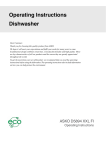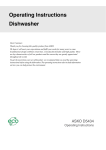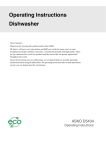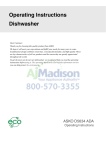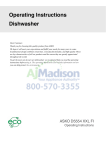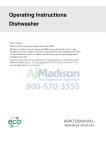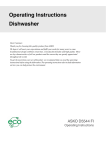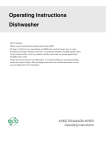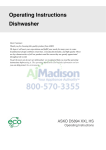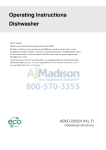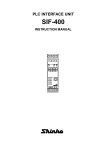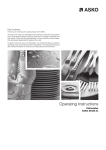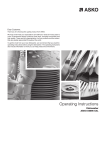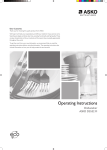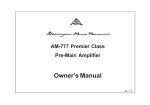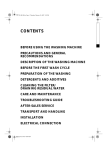Download Operating Instructions Dishwasher
Transcript
Operating Instructions Dishwasher ISE D243W Operating Instructions Dishwasher D243W Dear ISE customer! We hope that you will have many years of use from your new machine. The machine has many features. To make the most of its functions, we recommend that you read the operating instructions before using the machine. The operating instructions include information on how you can help protect the environment. Contents Before washing for the first time Read the operating instructions 3 Troubleshooting 28 3 31 Be careful with certain materials 3 Information for test institute Energy labelling Checking water hardness 3 Dosages during testing 31 4 Loading the dishwasher 31 Safety instructions General 2 4 Technical information Information on energy labelling 31 32 Installation 4 Winter storage/Transport 4 Overflow guard function 4 Cleaning 4 Packing material 4 Suggested machine installations 34 Disposal 4 34 Technical data Installation Safety instructions 32 32 33 33 Child safety Child safety and dishwashing 5 5 Adjust the height and slide the dishwasher into place Drainage connection Activate the child safety lock 5 Connection to water supply 35 Activate child lock (button lock) 5 Electrical connection 36 Dishwasher components 6 Dishwasher baskets 7 Front panel 9 Dispenser 10 Economic dishwashing 11 Fragile dishes 12 Dishwashing Load the baskets correctly 13 13 Add detergent 13 Select the programme 14 Select options 16 After dishwashing 17 Settings 18 Time remaining 21 Care and cleaning 22 Rinse aid 25 Salt Top up with salt 26 Error messages 27 26 35 Attaching sealing strip (to floor plinth cover panel) Service 36 Quick guide 40 37 Before washing for the first time Read the operating instructions Read through the operating instructions before using the dishwasher, especially the sections Safety instructions, Child safety and Dishwashing. Be careful with certain materials Read the section Fragile dishes before dishwashing porcelain with unglazed decoration or other utensils made from plastic, wood or crystal that you value. Checking water hardness Contact the local waterworks to check the water hardness in your area. This is important when adjusting the water softener (see the section Settings). Before you begin washing, you may also need to fill up the salt (see the section Salt). Once you have adjusted the water softener, use detergent and rinse aid doses suitable for soft water. 3 Safety instructions General Overflow guard function • Read the operating instructions and keep them in a safe place! • Never use the dishwasher for any purpose other than that specified in these operating instructions. • Do not load the dishwasher door or dishwasher baskets with anything other than dishes. • Never leave the dishwasher door open as someone may trip on it. • Use only dishwasher detergent! • Place knives and other sharp items so that they cannot harm anyone or damage the dishwasher. • The machine is not designed to be used by persons (even children) that are physically or mentally handicapped or lack experience and knowledge. Such persons must receive instruction in how to use the machine from the person responsible for their safety. • Children must be watched to ensure they do not play with the dishwasher. • Damaged mains cables must only be replaced by a qualified electrician. • This dishwasher is for household or similar use, such as: - staff kitchens in shops, offices and other workplaces. - farms. - for guests at hotels, motels and other types of accommodation. - bed & breakfast hotels. The overflow protection starts pumping out the machine and turns off the water supply if the water level in the dishwasher exceeds the normal level. If the overflow protection is triggered, turn off the water supply and call the service division. • Never place dishes with solvent residues in the dishwasher due to the risk of explosion. Nor may dishes that contain ash, wax or lubricants be washed in the dishwasher. Installation See the section Installation. Winter storage/Transport • Store the dishwasher where the temperature remains above freezing. • Avoid long transport distances in very cold weather. • Transport the dishwasher upright or laying on its back. 4 Cleaning When cleaning the edge around the door, use only a slightly damp cloth. Do not spray water around the edge! Moisture can make its way into the lock, which contains electrical components. Packing material Please sort waste materials in accordance with local guidelines. Disposal • When the dishwasher has reached the end of its service life and is to be disposed of, it should immediately be made unusable. Pull out the power cable and cut it as short as possible. • The dishwasher is manufactured and labelled for recycling. • Contact your local authority for information about where and how your dishwasher should be correctly recycled. Child safety Child safety and dishwashing Activate the child safety lock • Use the knife stand for all long/sharp items. • Always close the door and start the programme immediately after you have added the detergent. • Keep children away from the dishwasher when the door is open. Some detergent may remain inside! • Do not allow children to use or play with the dishwasher. Be especially vigilant when the door is open. (only certain models) WARNING! Children must be supervised – dishwasher detergent is corrosive! Store detergent and rinse aid out of the reach of children! If anyone swallows dishwasher detergent, they should immediately drink one or two glasses of milk or water. Do not attempt to induce vomiting. Contact a doctor! If anyone gets dishwasher detergent in their eyes, rinse (for at least 15 minutes) with plenty of water. A child safety lock is fitted to prevent children from opening the dishwasher door. To activate the child safety lock, press in the door latch and use a screwdriver to turn the screw slot (top left-hand corner) to a vertical position. To open the door, you must press the white plastic catch (illustrated below) to the left while pressing the door latch up. Reset by turning the screw slot back to a horizontal position. Locked Open Activate child lock (button lock) You can activate the child lock (button lock) to prevent children from starting the dishwasher (see the section Settings). 5 Dishwasher components* 5 6 7 6 1 8 2 9 3 10 4 11 1. 2. 3. 4. 5. 6. Filters Cutlery basket Detergent compartment Main power switch Upper basket Spray arms 7. 8. 9. 10. 11. *Specifications may differ depending on the model and market. 6 Serial number plate Salt compartment Lower basket Rinse aid compartment Panel Dishwasher baskets* Upper basket 1 2 1. Wine glass shelf 2. Cup shelf 3. Knife guard 3 Lower basket 1 2 1 1. Fold-down plate support 2. Forward mount for plate support (used for plates with a diameter greater than 25 cm) 3. Handle 3 2 Cutlery basket a b c *Specifications may differ depending on the model and market. 7 Dishwasher baskets* Cutlery basket with lid a b c Positioning of cutlery basket lid (in upper basket) The cutlery basket lid can be removed and used, for example, as an extra cutlery basket in the upper basket (see below). a b c *Specifications may differ depending on the model and market. 8 Front panel The panel is fitted with touch buttons with audible feedback (see the chapter Settings). 1 11 1. 2. 3. 4. 5. 6. 7. 8. 2 3 12 Auto wash Heavy wash Normal wash Eco wash Quick wash Rinse & Hold Child lock (button lock) Salt indicator 4 13 5 6 7 8 9 10 15 16 14 9. 10. 11. 12. 13. 14. 15. 16. Rinse aid indicator TAB (3-in-1/all-in-one detergent) Programme selector High temperature Long dry Delayed start Start/Stop Display NOTE! • Keep the touch buttons clean and free from grease. Wipe them clean with a dry or slightly damp cloth. Never use cleaners – they can scratch the surface. Use the main power switch to turn off the dishwasher before cleaning the touch buttons to avoid activating any buttons unintentionally. 9 Dispenser 1 3 2 1. 2. 3. 4. 5. 4 10 5 Prewash detergent compartment Main wash detergent compartment Rinse aid compartment Detergent compartment lid Rinse aid compartment lid Economic dishwashing Run programmes only with a full load Wait to run a programme until the dishwasher is full, this way you save energy. Use the Rinse & Hold programme to rinse the dishes if there are any unpleasant odours while you wait for the dishwasher to become fully loaded. Run programmes at a lower temperature If the dishes are only slightly dirty, you can select a lower temperature with certain programmes. See also the section Select options in the chapter Dishwashing. Select a programme with Short dry To save energy, use Short dry. The drying result will be better if, once the programme is finished, you leave the door slightly open. Do not rinse under running water Simply scrape off large food particles before loading the dishwasher. Choose a green detergent Read the environmental declaration on the packaging! Connect to cold water... If you use oil or electricity to heat your home. Connect to hot water (max. 70 °C)... If you use district heating, solar power or geothermal power to heat your home. Choosing a hot water connection cuts programme times and reduces the dishwasher's electricity consumption. 11 Fragile dishes Some cookware is not dishwasher safe. This can be for several reasons. Some materials cannot withstand strong heat, others can be damaged by dishwashing detergent. Fragile decoration Porcelain with decoration on top of the glazing (the items feel rough) should not be washed in a dishwasher. Crystal / Glass Position items so that they do not touch each other during the wash. Use the lowest possible wash temperature and the shortest possible programme. Select Short dry. Antique and very fragile items should not be washed in a dishwasher. Glass washed in a dishwasher at high temperatures can gradually develop a grey film that cannot be removed. Wash fragile glasses at a low temperature and with a small amount of detergent. Silver Silver and stainless steel items should not come into contact, as the silver can become discoloured. Cutlery with glued handles Some types of glue are not dishwasher safe. In such cases, the handles may loosen. Wood Wooden items should only be washed in a dishwasher if marked dishwasher safe. Aluminium Aluminium can lose its shine if washed in a dishwasher. However, good quality aluminium pans can be washed in a dishwasher, even if some of the shine will be lost. Plastic items Avoid washing plastic items that cannot withstand high temperatures. 12 Dishwashing Below are step-by-step instructions to help you achieve the best possible dishwashing results. 1 Load the baskets correctly Do not rinse dishes under running water before loading them in the dishwasher. Simply scrape off large food particles before loading the dishwasher. See the section Fragile dishes if you want to wash items that may be considered fragile. Upper basket Place glasses, cups, bowls, side plates and saucers in the upper basket. Wine glasses are placed on the wine glass shelf and knives are placed in the knife stand on the right (if fitted). Cutlery basket Place cutlery with the handles facing down, except for knives, and spread them out as much as possible. Ensure that spoons do not stack inside each other. The cutlery basket is placed in the lower basket. WARNING! Knives and other pointed items must be placed with the points down in the cutlery basket or horizontally in other baskets. NOTE! Do not place cutlery made of different materials, such as silver and stainless steel, in the same place (risk of discolouration). All dirty surfaces should face inwards and downwards! The cutlery basket has a fold-down section in the middle for small items, or small shafts, such as electric whisk attachments. 2 3 Check that the spray arms can rotate freely Add detergent Detergent is added according to water hardness. Follow the instructions on the detergent packaging. This dishwasher is fitted with a water softener, so use detergent and rinse aid doses suitable for soft water. Lower basket Place plates, side plates, serving dishes, pots and cutlery (in the cutlery basket) in the lower basket. Lower the fold-down plate supports when washing pots. Too much detergent can result in less effective dishwashing and also entails greater environmental impact. Add the detergent to the detergent compartment. There is one compartment for the prewash and one for the main wash (see the section Dispenser). If tablets are not used, add a small amount of the detergent to the prewash compartment. Contact the detergent manufacturer if you have any questions about the detergent. WARNING! Children must be supervised – dishwasher detergent is corrosive! 13 Dishwashing NOTE! Use only dishwasher detergent! Washing up liquid must not be used as the foam that forms prevents the dishwasher from operating effectively. Dishwasher tablets Halve the tablet if it is difficult to close the dispenser lid. There is a risk that the detergent will not be released properly if the lid is tight and will not open correctly. NOTE! Dishwasher tablets are not recommended for short programmes (less than 75 minutes). Use powder or liquid dishwasher detergent instead. 3-in-1/ All-in-one detergent Read through the directions for these products carefully. If anything is unclear, contact the detergent manufacturer. 4 5 Press the main power switch and close the door Select the programme Press the Programme selector one or more times until the desired programme symbol lights. Auto wash The dishwasher can measure how dirty the dishes are and adjust water consumption and temperature accordingly. When newly installed, the programme needs to be run five times before it is fully adapted and can provide the best results. Heavy wash Programme for very dirty dishes, such as pans, casserole dishes and oven dishes. If these dishes do not completely fill the dishwasher, you can add plates and the like. Normal wash Use to wash normally dirty dishes, and even dishes with dried leftovers, such as plates, serving dishes, cups, glasses and so on. Eco wash Use when you want to save energy. For normally dirty dishes. Quick wash This programme is used for glasses and porcelain that is slightly dirty, such as coffee cups. Rinse & Hold Used to rinse dishes while you wait for the dishwasher to become fully loaded. 14 4) 3) 2) 1) - Quick wash 0 1 30 55 65 60 55 55-65 2 2 3 2 3 2-4 - 55 65 60 60 65 0:20 2:40 2:30 2:55 3:15 1:50-2:50 0,2 1,0 1,6 1,0 1,3 1,3-1,6 0:20 2:20 2:20 2:35 3:00 1:40-2:40 0,1 0,6 1,0 0,7 0,7 0,7-1,0 10 12 20 11 18 13-26 Rinse & Hold 0 1 0:06 0,01 0:06 0,01 3 Consumption values vary depending on the water supply temperature, the ambient temperature, the size of the load, the selected options and more. Connection to cold water, approx. 15 °C. Connection to hot water, approx. 60 °C. The energy label performance figures are based on this programme. - Eco wash 2 2 1-3 Normal wash - 1) PreMain Number Final Consumption values rinse tem2) 3) washes wash (°C) of Cold water Hot water rinses perature Wash time Energy Wash time Energy Water con(°C) (approx. (approx. kWh) (approx. (approx. kWh) sumption (liter) hours:minutes) hours:minutes) 0 4) - Options Normal wash - Heavy wash Auto wash Program Dishwashing Programme chart 15 Dishwashing 6 Select options To select an option, press one of the option buttons. The indicator lamp for a button lights when the option is activated. The available options depend on the selected programme. Once you have started the programme, the options you selected are saved for the next time you use the same programme. An exception is the Delayed start option. High temperature Activate this option for improved dishwashing results. The machine then uses a higher temperature for the main wash. NOTE! Remember to press the Start/Stop button to start the programme. 7 Press Start/Stop The display flashes three times with the remaining time to indicate that the programme has started. Close the door properly, otherwise the dishwasher will not start. The display indicates if the door is open. NOTE! If you want to use the lower temperature, press so that the indicator lamp turns off. If the machine does not start within 2 minutes of the last button press, the display returns to showing the last programme run. You can vary the temperature as shown below: Stopping or changing a programme Heavy wash: 55 °C/ 70 °C Normal wash: 60 °C/ 65 °C Quick wash: 30 °C/ 60 °C Eco wash: 55 °C/ 60 °C In order not to accidently press a button and cancel the current programme, you must press and hold Start/Stop for five seconds if you want to change programmes after starting the dishwasher. Add more detergent if the lid of the detergent dispenser has opened. Then choose a new programme and press Start/Stop. Do you want to add more dishes? Long dry A higher temperature in the final rinse and a longer drying phase improves the drying result if you activate the Long dry option. This causes a slight increase in energy consumption. This option can be used with all programmes except Auto wash. If you want a programme with Short dry, press so that the indicator lamp turns off. Delayed start When you select Delayed start, the dishwasher will start 1-24 hours after you press the Start/Stop button. 1. Press the button once to activate Delayed start. Press the button several times – or hold it in – to set the desired number of hours. 2. Press Start/Stop and the dishwasher counts down 1 hour at a time and starts after the selected delay. Press and hold Start/Stop for five seconds if you want to cancel the Delayed start option. 16 Open the door. The dishwasher stops automatically. Add the dishes, close the door and the dishwasher continues the programme. If the dishwasher is turned off using the main power switch or due to a power failure If the dishwashing programme was not finished, the interrupted programme continues when power is restored. NOTE! During drying, the programme is interrupted if the power is cut or the door is open for more than 2 minutes. Dishwashing 8 After dishwashing Once the programme has finished, "End" appears on the display. A buzzer also sounds at the end of the programme. See the section Settings, which describes how to change this function. Once the dishwasher has finished, it uses only standby power. Turn off the dishwasher using the main power switch if you want to completely cut the power. Turn off the water supply valve after each use. 17 Settings Do as follows to open the settings menu: 1. Turn off the dishwasher using the main power switch. Wait about five seconds. 2. Then press the main power switch again. Wait until the numbers appear in the right-hand display before continuing to the next step. + 3. Within five seconds, press and hold the Programme selector (wait for the audible signal confirming the button press) and then immediately press the Long dry button without releasing the Programme selector. 4. Keep the buttons pressed until the symbols for the Auto wash and Rinse & Hold programmes start to flash. TIP! Be sure to press right on the symbols, so as not to inadvertently activate any other button. Try again if you fail to open the settings menu the first time. Press to browse between setting values. Current setting value. Press to save the set value and continue to the next setting. Display Current setting. You can now adjust the following settings: Button press Options (Off) (On) Settings Description Child lock (button lock) You can activate the child lock (button lock) option to prevent children from starting the dishwasher. Press the High temperature and Long dry buttons simultaneously to temporarily deactivate the button lock when you want to start the dishwasher. The button lock is automatically reactivated after 2 minutes. Press Start/Stop to save the setting value and continue to the next setting. If you do not want to change any other settings, keep pressing Start/Stop to step through the entire settings menu. 18 Settings Button press Options (Off) Settings Description Buzzer volume The dishwasher uses a buzzer to indicate when a programme is finished or when a fault has occurred. (Low) (High) Press Start/Stop to save the setting value and continue to the next setting. (Off) Operation volume This sound is used to confirm each button press. (Low) (High) Press Start/Stop to save the setting value and continue to the next setting. (Low) LCD contrast For adjusting the contrast of the display. (High) Press Start/Stop to save the setting value and continue to the next setting. (Off) Rinse aid Rinse aid dosage setting. (Low dosage) (High dosage) Press Start/Stop to save the setting value and continue to the next setting. 19 Settings Button press Options (Off) (On) Settings Description TAB (3-in-1/all-in-one detergent) This option can be activated when using 3-in-1/allin-one detergents. The dishwashing programme automatically adapts to provide the best possible dishwashing and drying results every time. If you deactivate this option, the dishwasher will return to ordinary function for all programmes. If this setting is activated there is no need to add rinse aid since this option disables rinse aid dispensing. It also reduces the amount of salt added to the water softener. NOTE! In order to achieve good dishwashing results, it is essential to check which type of detergent or all-in-one product best suits your needs! Read the detergent packaging carefully for information on proper use. Always follow the directions for use or information on the detergent packaging! Press Start/Stop to save the setting value and continue to the next setting. (Soft water) Water hardness (Hard water) Press Start/Stop to exit the settings menu. 20 If your dishwasher is fitted with a water softener you may need to adjust its setting depending on the water hardness. Contact the local waterworks to check the water hardness in your area. Water hardness is specified using the following scales: The German water hardness scale (°dH) and the French water hardness scale (°fH). 0=low water hardness. °dH °fH 0-5 0-9 6-8 9-14 9-11 15-20 12-14 21-25 15-19 26-34 20-24 35-43 25-29 44-52 30-39 53-70 40-49 71-88 50+ 89+ Time remaining Once you have selected a programme and options, the display indicates how long the programme took the last time it was used.Once you have started the dishwasher, the display indicates how much programme time remains. The remaining time is updated after the water for the final rinse has been heated. This may differ somewhat from time to time depending on the temperature of the water supply, the amount of dishes, the ambient temperature and other factors. While the programme is running, the time counts down and the remaining programme time is shown on the display. The remaining time is shown, for example, as 1:15, which means the programme will run for another 1 hour and 15 minutes. NOTE! During the first run of each programme, the remaining time displayed can be slightly misleading, as the dishwasher is estimating the time. When you run the programme a second time, the dishwasher will calculate the remaining time based on the previous duration of the programme. 21 Care and cleaning The dishwasher tub is made of stainless steel and is kept clean through normal use. However, if you have hard water, limescale deposits may form in the dishwasher. If this happens, run the Normal wash programme with high temperature and two tablespoons of citric acid in the detergent compartment (with no dishes in the machine). 1. Turn the handle anticlockwise once. Spray arm 1x Pipe section Fine filter 2. Lift the pipe section straight up by the handle. Free the coarse filter to clean the pipe section. 3. Remove and clean the fine filter. 4. Replace in reverse order. Check that the edges seal properly when replacing the fine filter. Coarse filter Coarse filter The coarse filter traps larger food particles, which cannot get past the drainage pump. Empty the coarse filter as necessary. 1. Lift the coarse filter by the handle. 2. Empty the coarse filter. Remember to replace it! 5. Lock the filter in place by turning the handle clockwise to the stop position. The handle should point straight out from the dishwasher. Fine filter Debris that collects on the fine filter is automatically rinsed away during each wash. However, the fine filter and its pipe section should be cleaned a couple of times a year. 1x NOTE! The dishwasher must not be used without the filter in place! Dishwashing efficiency can be affected if the coarse filter is incorrectly fitted. 22 Care and cleaning Drainage pump NOTE! The pump can be accessed from inside the dishwasher. 1. Cut the power to the dishwasher by pulling out the plug from the wall socket! 2. Remove the coarse filter and pipe section. 3. Remove the small yellow fitted piece at the left of the bottom drain (see illustration below). Do not forget to reinstall the fitted piece. Lower spray arm Holes and bearings can sometimes become blocked. 1. Pull the lower spray arm straight up to release it. 2. Remove any debris using a needle or the like. The spray arms also have holes underneath. 4. By inserting your finger into the hole you can turn the pump blade to release anything blocking it. 5. Reinstall the fitted piece and filters. 6. Plug the machine in again. Upper spray arm The upper basket must be removed before the upper spray arm can be released. 1. Pull out the upper basket and turn the basket catch on each runner outwards (see illustration). The basket can now be removed. If the dishwasher still does not start and a whirring sound is heard, the overflow protection has been activated. • Shut off the water. • Remove the plug from the wall socket. • Call the service division. 2. Loosen the upper spray arm in the same manner as the lower spray arm and clean it. 23 Care and cleaning Door When cleaning the edge around the door, use only a slightly damp cloth (with a little cleaner if necessary). WARNING! Do not use a spray bottle or the like around the door lock. This is to ensure that water does not penetrate the door catch and come into contact with the electrical components. 24 Rinse aid Select dosage Drying is faster if you use rinse aid. When the rinse aid needs topping up, the above symbol lights on the display. Top up with rinse aid Top up with rinse aid as follows: 1. Open the rinse aid compartment lid. The rinse aid dispenser can be adjusted between 0 (off) and 6. Increase the rinse aid dosage: • If the dishes have water marks. Reduce the rinse aid dosage: • If the dishes have a sticky white/blue film. • If the dishes are streaked. • Build-up of foam. If you have very soft water, the rinse aid can be diluted 50:50 with water. Set the dosage The section Settings describes how to set the rinse aid dosage. 2. Carefully top up with rinse aid. Only add rinse aid to the level marked max. 3. Wipe up any splashes of rinse aid around the compartment. 4. Close the lid firmly. NOTE! After topping up, it may take a while before the symbol goes out. 25 Salt When the salt needs topping up, the above symbol lights on the display. Top up with salt When the salt runs out, unscrew the lid and fill the compartment with salt. Water is only added the first time! Wipe clean and tighten the lid. Run the Normal wash programme with high temperature so that any salt in the dishwasher is rinsed away. Before you begin using a dishwasher with a water softener, you must fill the salt compartment with salt. Use large grain salt or special dishwasher salt. NOTE! Top up the salt just before running a programme. To avoid the risk of rust stains, the dishwasher must be rinsed immediately after topping up the salt. Do as follows the first time: 1. Unscrew the lid as illustrated. 2. Place the funnel supplied with the dishwasher in the salt compartment top-up hole. First, pour in about 1 l of water. 3. Then add salt, a maximum of 1,5 kg, until the compartment is full. 4. Wipe up any excess salt so that the lid can be screwed on firmly. 5. Run the Normal wash programme with high temperature so that any salt in the dishwasher is rinsed away. 26 Salt compartment lid NOTE! After topping up, it may take a while before the symbol goes out. WARNING! Never pour dishwasher detergent into the salt compartment. This destroys the water softener! Error messages Display Type of fault Action Overfilling Call the service division. Water outlet fault See "Possible causes" in the chapter Troubleshooting. Water inlet fault Check that the water tap is on. Inlet valve leakage Turn off the water tap and call the service division Turn off the machine with the main power switch and then turn it on again to clear the error message from the display. 27 Troubleshooting Problem Possible causes Action The dishes are not clean. The spray arms do not rotate. Remove the arms and clean them. Check that the dishes are not blocking the spray arms. Old detergent. Detergent is a perishable product. Avoid large packages. Incorrect detergent dosage. Dose according to water hardness. Far too much or far too little detergent results in poorer dishwashing results. Dishwashing programme too weak. Select a higher temperature or a more powerful programme. Dishes loaded incorrectly. Do not cover porcelain with large bowls or the like. Avoid placing very tall glasses in the corners of the baskets. Glasses and cups have toppled over during the programme. Place dishes to sit steady. The filter is not correctly fitted. Screw the filter firmly into place. See the section Care and cleaning. The water softener is leaking salt. Check that the salt compartment lid is properly tightened. Otherwise call the service division. Incorrect water softener setting. See the section Settings. Incorrect rinse aid dosage setting. See the sections Rinse aid and Settings. Salt compartment empty. Top up with salt. See the section Salt. Too high temperature and/or too much detergent can cause etching on crystal. Unfortunately, this cannot be repaired, only prevented. Wash crystal at a low temperature and with a conservative amount of detergent. Contact the detergent manufacturer. The dishes have a sticky white/blue film. Rinse aid dosage setting too high. Reduce the amount. See the sections Rinse aid and Settings. If you have very soft water, you may want to dilute the rinse aid 50:50 with water. Spots on stainless steel or silver. Some foodstuffs, such as mustard, mayonnaise, lemon, vinegar, salt and dressings, can cause spots on stainless steel if left for too long. Rinse off these types of foodstuffs if not starting the dishwasher immediately. Why not use the Rinse & Hold programme. Spots or films on the dishes. All stainless steel can cause spots on Silver and stainless steel items should silver if they come into contact during not come into contact during dishwashdishwashing. Aluminium can also ing. cause spots on dishes. Spots left after washing. 28 Lipstick and tea can be difficult to wash Use a detergent with a bleaching off. agent. Troubleshooting Problem Possible causes Action Rattling sound when dishwashing. The dishes are not correctly placed or Check that the dishes are placed sethe spray arms are not rotating. curely. Spin the spray arms to make sure they can rotate. The dishwasher does not start. You have forgotten to turn on the main Press the main power switch. power switch. The door is not properly closed. Check. A fuse/circuit breaker has been tripped. Check. The plug is not plugged into the wall socket. Check. The water tap is turned off. Check. Overflow/leaks. Check. A whirring sound (the drainage pump) Turn off the water tap. Pull out the plug is heard from the dishwasher and does and call the service division. not stop when the main power switch is turned off. Check that the Delayed start option has not been selected. Press and hold Start/Stop for five seconds if you want to cancel the Delayed start option. 1 minute appears in the display. The programme is taking longer than None, next time the programme is run estimated. the corrected time will be displayed. Water remains in the dishwasher. Blocked drainage hose. Loosen the drainage hose where it connects to the sink unit's water trap. Check that no debris has fastened. Is the cone-shaped part of the pipe cut to an inner diameter of at least 14 mm? Kink in drainage hose. Check that the hose is free from kinks and sharp bends. The filters are blocked. Clean the coarse and fine filters. Debris in the drainage pump. Clean the drainage pump. See the section Care and cleaning. Dirt around the seals and in corners. Clean with washing-up brush and low foaming cleaner. Bad odour in dishwasher. Low temperature programmes have Run a programme with a higher tembeen selected for a prolonged period. perature about once a month. 29 Troubleshooting Problem Possible causes Action The dishes are not dry enough. Drying power too low. Activate the Long dry option. The dishwasher is not fully loaded. Fully load the dishwasher. Rinse aid needs topping up or dosage Top up with rinse add or increase the is set too low. rinse aid dosage. See the sections Rinse aid and Settings. Open the door a little once the programme has finished. Cannot close door. The baskets are not correctly positioned. Check that the baskets are correctly positioned horizontally. Check that the dishes are not blocking the baskets from sliding properly into place. The touch buttons do not react when You have pressed the touch buttons pressed. too soon after opening the door. 30 Wait a moment then try again. Dirt on the touch buttons. Clean with a dry or slightly damp cloth. Child lock (button lock) activated. See the section Settings. Information for test institute Energy labelling European test standard: EN 50242 Number of standard place settings: 13 Dishwashing programmes: Normal wash, no options Connection: Cold water 15 °C Test method for noise measurement: IEC 60704-2-3 Dosages during testing Detergent: In accordance with EN 50242 Prewash: 7,5 gram Main wash: 25 gram Rinse aid: In accordance with EN 50242 Rinse aid dosage: 5 Loading the dishwasher a b c b a egg b minced meat c spinach 2 2 2 8 2 8 2 1 2 5 5 1 5 5 1 1 5 5 5 5 1 1 7 1 5 1 1 4 5 3 5 5 5 3 2 2 2 3 3 3 4 1 3 3 3 4 1 3 2 2 2 4 4 1 4 4 4 6 1 3 4 4 4 4 3 2 4 3 1. 2. 3. 4. 5. 6. 7. 8. Teaspoons Dessertspoons Soupspoons Forks Knives Serving cutlery – fork Serving cutlery – gravy ladle Serving cutlery – spoons 3 31 Technical information Information on energy labelling Information sheet, in compliance with Commission Delegated Regulation (EU) No. 1059/2010 ISE Model designation: D243W Number of standard place settings: 13 Energy efficiency class: A+ Annual energy consumption (AEC): 295 kWh per year 1) 2) Energy consumption of the standard cleaning cycle (Et): 1,04 kWh Power consumption Off-mode (Po): 0,12 W Left-on mode (Pl): 0,75 W 3) Annual water consumption (AWC): 2990 litres per year Drying efficiency class: A Dishwashing programmes: Normal wash, no options Programme time for the standard cleaning cycle: 175 minutes Duration of the left-on mode (Tl): Infinite Noise emissions: 44 dB(A) re 1 pW 4) 5) 1) In accordance with standard, EN 50242. 2) Based on 280 standard cleaning cycles with a cold water connection and consumption in accordance with energy saving mode. The actual energy consumption depends on how the machine is used. 3) Based on 280 standard cleaning cycles. The actual water consumption depends on how the machine is used. 4) On a scale from G (least efficient) to A (most efficient). 5) This dishwashing programme is the standard cleaning cycle used to compile the energy labelling information. It is intended for washing normally dirty dishes and is the most effective programme in terms of combined energy and water consumption. Technical data Height: 847-905 mm Width: 600 mm Depth: 596 mm Weight: 67 kg Water pressure: 0.03–1.0 MPa 1) 2 0.3–10 kp/cm 2 3–100 N/cm Electrical connection: See type plate. Rated power: See type plate. 1) Weight can vary due to different specifications. 32 Installation [mm] 1235 596 556 93 700 670 717 831 861 - 905 127 - 170 30 600 32 Remove rubber feet, locking nuts and coasters for an installed height of 850-861 mm. Safety instructions • Connections to electricity, water and drainage must be performed by a qualified professional. • Electrical, water and drainage installations must be carried out by a qualified professional. • Always follow applicable regulations for water, drainage and electricity. • An incorrect or flawed installation can result in higher consumption of energy, water and detergent, which can result in increased costs and poor dishwashing results. In order to minimise noise it is important that you follow the instructions. • Exercise caution during installation! Use protective gloves! Always have someone assist you! • Place a watertight protective tray on the floor under the dishwasher to prevent damage from any water leaks. • Before screwing the dishwasher into place, test the dishwasher by running the Rinse & Hold programme. Check that the dishwasher fills with water and drains. Check also that none of the connections leak. WARNING! The plug must be disconnected or power to the socket turned off while the work is carried out! WARNING! Turn off the water supply when installing the dishwasher! 33 Installation Suggested machine installations Built-in The dishwasher is intended for freestanding installation, but can also be installed under a worktop. Check that there is an air gap of 3 mm around the dishwasher. 1. Attach the coasters (if applicable) to the dishwasher. Adjust the height and slide the dishwasher into place Freestanding 1. Attach the coasters (if applicable) to the dishwasher. 2. Make sure the area on which the dishwasher is to be installed is firm. Adjust the dishwasher's height using the four steel feet so that the dishwasher is level. The dishwasher may lean no more than 5 mm. 3. Lock the steel feet with the lock nuts. 2. Start by measuring the height from the floor to the bottom edge of the worktop. 3. Measure the height from the floor to the top edge of the dishwasher. 4. Adjust all feet by turning them clockwise to raise or anticlockwise to lower the dishwasher. 5. Check that there is an air gap of at least 3 mm between the underside of the worktop and the top edge of the dishwasher. 6. Tighten the lock nuts (lock nut) on the rear feet. 7. Slide the dishwasher into place. • Pull through the drainage and supply hoses when the machine is slid into place. • Check that the hoses have no kinks or sharp bends, and check that there is nothing that can damage the hoses. Steel feet 4. Once the steel feet are properly adjusted, tighten the two rubber feet against the floor. The rubber feet now prevent the machine from tipping over. 8. Make any final adjustments to the front feet (the dishwasher may lean no more than 5 mm) and tighten the lock nuts. 34 Installation 9. Once the steel feet are properly adjusted, tighten the two rubber feet against the floor. The rubber feet now prevent the machine from tipping over. Max. 950 mm Min. 350 mm Min. 14 mm Figure 1 Drainage connection When the drainage hose is routed to a connection nipple on the sink unit's water trap (see illustration 1), please note that the hose must be attached at the same height as the underside of the sink unit, otherwise dishwater from the sink may flow back into the dishwasher. The drainage hose is threaded onto the cone-shaped connection pipe on the sink unit's water trap. The cone-shaped pipe must be cut to an internal diameter of at least 14 mm. For other connection alternatives, see illustrations 2 and 3. Max. 3 m Max. 950 mm Min. 350 mm Figure 2 The drainage hose may be extended by a maximum of 3 m (the total length of the drainage hose must not exceed 4,5 m). Any joins and connecting pipes must have an internal diameter of at least 14 mm. However, the drainage hose should ideally be replaced with a new hose without joins. No part of the drainage hose may be more than 950 mm above the bottom of the dishwasher. The hose must not be routed directly to a floor drain or the like. In such cases, the hose can act as a siphon and empty the dishwasher. The hose must always discharge at least 350 mm above the bottom of the machine. Ensure that the drainage hose has no kinks. NOTE! The hose must be attached at the same height as the underside of the sink. Max. 950 mm Min. 350 mm Figure 3 Connection to water supply Use only the supply hose provided with the dishwasher. Do not re-use old hoses or other spare supply hoses. The supply pipe must be fitted with a stopcock. The stopcock must be easily accessible, so that the water can be shut off if the dishwasher has to be moved. Once the installation is complete, the stopcock should be opened to allow the pressure to settle for a while and to check that all connections are tight. Connect to cold water... If you use oil or electricity to heat your home. 35 Installation Connect to hot water (max. 70 °C)... If you use district heating, solar power or geothermal power to heat your home. Choosing a hot water connection cuts programme times and reduces the dishwasher's electricity consumption. Electrical connection Information about the electrical connection can be found on the serial number plate This specification must match the electricity supply. Attaching sealing strip (to floor plinth cover panel) (Not applicable to all models) Follow these instructions: 1. Remove the plastic plinth by grabbing it with both hands with your fingers under the plastic plinth (A) and pulling it out and up. Dishwashers fitted with a plug must be connected to an earthed socket. The electric wall socket must be placed outside of the installation area to be easily accessible after installing the dishwasher. Do not use an extension cord! B NOTE! A Repairs and maintenance relating to safety or performance must be carried out by a qualified professional. 2. Unscrew the two screws on the cover panel (B). 3. Glue the supplied rubber seal (C) to the bottom edge of the cover panel (facing the floor). 4. Screw the cover panel back into place. Adjust the cover panel so that the rubber seal just touches the floor. x x C 5. Replace the plastic plinth. 36 Service Read the chapter Troubleshooting before contacting the service division. Make a note of the information on the serial number plate on the right inside the dishwasher. Note the type number (1) and the serial number (2). 1 TYPE SERIAL NO 2 37 Your notes 38 Your notes 39 Quick guide 1 Load the baskets Do not rinse dishes under running water before loading them in the dishwasher. Simply scrape off large food particles before loading the dishwasher. 2 3 Add detergent The detergent compartment has one smaller compartment for the prewash and one for the main wash. Check that the spray arms can rotate freely Art. No.: 8093332. Rev. 01. We reserve the right to make changes. 40 4 5 6 Press the main power switch and close the door Select a programme and any options Press Start/Stop












































